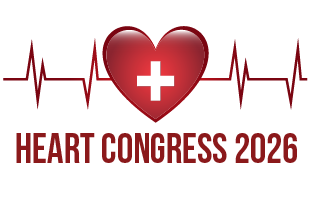3rd Global Summit on
Heart and Cardiovascular Care
November 26-27, 2026 | Dubai, UAE

Heart Congress 2026

National Research Center for Therapy and Preventive Medicine, Russia
Abstract:
Aim of the study: to determine the prevalence of the main risk factors and analyze the risk of developing cardiovascular complications in the adult population in the Vladimir region of the Russian Federation.Material and methods. The cross-sectional population-based study included 1,350 men and women aged 30-69 years from 5 cities of the Vladimir region (Vladimir, Kovrov, Murom, Yuryev-Polsky and Vyazniki). The response to the study was 87%. The study was completed by 1174 people (424 men - 36.1% and 750 women - 63.9%). Using a survey, instrumental and biochemical studies, the following risk factors were determined taking into account gender indicators: smoking, hypertension, hypercholesterolemia, hyperglycemia and obesity. The risk of developing fatal cardiovascular complications was assessed using the classic European SCORE scale. Depending on the total score, the risk was assessed as follows: low risk <1%, moderate risk - from 1% to 5%, high risk - from 5% to 9% and very high risk - 10-14%.Results. In the surveyed unorganized population, every third man is obese, while among women this figure was significantly high (33.7% versus 42.1%, p<0.001). The incidence of hypertension among men and women was comparable (41.5% and 39.9%, respectively). The frequency of tobacco smoking among men was 38.4%, which is 4 times higher than in women (p <0.0001). Every second person had a total cholesterol level > 5 mmol/l. Its frequency was comparable among men and women (53.2% and 51.5%, respectively). In 23.1% of women and in 18.5% of the unorganized population from 5 cities of the Vladimir region, fasting blood glucose above 6.1 mmol/l was detected.The high and very high risk of cardiovascular complications among men was 32%, among women the risk was 2 times lower (15.5%). Low and moderate risk predominated among women (66.3%), which is 1.5 times more common than men (43.6%). With comparable rates of hypertension and hypercholesterolemia, male gender and smoking status contributed to the total cardiovascular risk. The frequency of very high risk of cardiovascular complications among men in certain cities of the Vladimir region was 2.5-4 times higher compared to women. Conclusion. In the central part of the Russian Federation, every third man of working age has a high and very high cardiovascular risk, which is due to the high prevalence of smoking, hypercholesterolemia and hypertension. Among women, high and very high cardiovascular risk was 2 times lower (15.5%), while a high incidence of hypercholesterolemia and hypertension was also observed among them. Along with this, a high prevalence of important metabolic risk factors was determined in the examined sample of men and women. This situation once again emphasizes the importance of effective primary prevention of CVD at the population level.
Biography:
Dr. Mamedov was born on January 10, 1970, in Sheki, Azerbaijan, and is a distinguished Azerbaijani cardiologist based in Moscow, Russia. He completed his medical education at the Moscow Medical Academy named after I.M. Sechenov, followed by postgraduate and doctoral studies in cardiology at the National Research Center for Preventive Medicine. Since 2002, Dr. Mamedov has led the Department of Secondary Prevention of Chronic Non-infectious Diseases at the National Research Center for Therapy and Preventive Medicine. His research focuses on cardiovascular disease epidemiology, risk factors, and pharmacotherapy. Dr. Mamedov has authored 468 articles, 13 monographs, and holds a Hirsch index of 40. He serves as the President of the Cardioprogress Foundation, is on the board of the Russian Society of Cardiology, and is Editor-in-Chief of the International Journal of Heart and Vascular Diseases.
